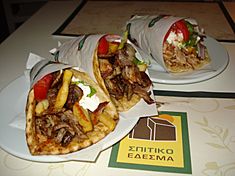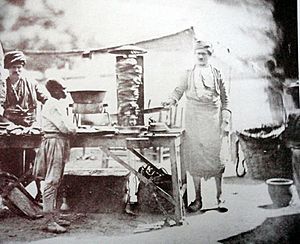Gyros facts for kids

|
|
| Alternative names | Gyro |
|---|---|
| Type | Meat wrap |
| Course | Main course |
| Place of origin | Greece |
| Serving temperature | Hot |
| Main ingredients | Meat: pork, chicken, beef, or mutton |
Gyros is a super popular Greek dish! It's made with meat cooked on a tall, spinning rotisserie. Think of it like a giant kebab that turns slowly. The meat is sliced off in thin, crispy pieces as it cooks.
People usually eat gyros wrapped in soft pita bread. Inside, you'll find tasty toppings like sliced tomato, chopped onion, and crispy fried potatoes. A creamy sauce called tzatziki (made with yogurt, cucumber, and garlic) is often added too. In Greece, gyros is usually made with pork or chicken. In other countries, you might find it with beef or lamb. It's a delicious and quick meal!
The History of Gyros

The idea of cooking stacked meat on a vertical spit and slicing it off as it cooks started a long time ago. It began in the 1800s in a place called Bursa, in the Ottoman Empire. This dish was known as doner kebab.
After World War II, doner kebab made its way to Athens, Greece. People who moved from places like Anatolia and the Middle East brought the recipe with them. The Greek version of this dish became known as gyros. It was often made with pork and served with tzatziki sauce.
By the 1970s, gyros wraps were a very popular fast food in Athens. They also became a hit in big American cities like Chicago and New York City. Even though machines were being made to cook the meat, the stacks of meat were still put together by hand. Many people claim they were the first to bring mass-produced gyros to the United States!
What's in a Name?
The word "gyros" comes from the Greek word γύρος (pronounced yíros). It means "circle" or "turn." This name is like a direct translation of the Turkish word döner, which also means "turn."
In Greece, the dish was first called ντονέρ (doner). But in the mid-1970s, some people in Greece didn't like using a Turkish word. So, the name "gyros" became more popular for the Greek version of the dish.
Sometimes, in English, people say "gyro" (without the 's') when they mean just one. But in Greek, "gyros" is already the singular word! It's a bit confusing, but both "gyro" and "gyros" are used today.
How Gyros is Made
In Greece, gyros is usually made with pork. But in other countries, you might find it made with chicken, lamb, or beef. In America, many mass-produced gyros are made from finely ground beef mixed with lamb.
To make gyros by hand, thin, round slices of meat are stacked up on a tall spit. This stack of meat looks like an upside-down cone. Spices like cumin, oregano, thyme, and rosemary are often added to give it flavor.
The meat cone is placed on a vertical rotisserie that spins slowly in front of a heat source. As the meat cooks, the juices from the top drip down, keeping the lower parts moist and flavorful. When the outside of the meat is cooked and crispy, thin shavings are sliced off vertically.
The cook can control how fast the meat cooks. They can change the heat, how close the meat is to the heat, and how fast the spit spins. This helps them make sure the gyros is perfectly cooked and ready when people want to eat it!
In Greece, gyros is typically served in a warm, lightly grilled piece of pita bread. It's rolled up with sliced tomatoes, chopped onions, lettuce, and fried potatoes. Often, it's topped with tzatziki sauce. In some parts of northern Greece, you might even find it with ketchup or mustard!
See also
 In Spanish: Gyros para niños
In Spanish: Gyros para niños



